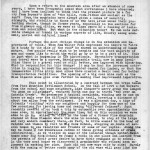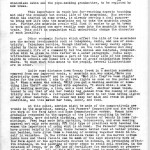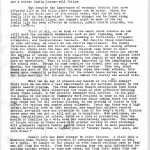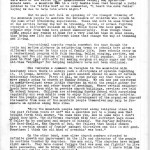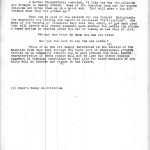Pine Mountain Settlement School
Series 09: Biography – Staff/Personnel
CONTENTS – Margaret Motter Writing: “Time Marches on in the Hinterlands” [5 pages]
Miss Motter describes changes in the mountain area since 1929 ; extension and improvement of roads due to logging and mining needs ; social and economic changes brought by roads ; changes brought by telephone, radio, and electricity ; new trends brought by Farmers’ Cooperative, Farm Agent and Home Demonstration workers ; changes in family life brought by schools, public health programs, etc. ; health care improvements ; new ideas brought in by returning children ; increased church attendance ; hope for future ;
GALLERY – Margaret Motter Writing: “Time Marches on in the Hinterlands”
- Time Marches On_motter_D2_02005.jpg
- Time Marches On_motter_D2_02006.jpg
- Time Marches On_motter_D2_02007.jpg
- Time Marches On_motter_D2_02008.jpg
- Time Marches On_motter_D2_02009.jpg
TRANSCRIPTION – Margaret Motter Writing: “Time Marches on in the Hinterlands”
Upon a return to the mountain area after an absence of some years, I have been frequently asked what differences I have observed; and I have been inclined to think that the present picture is a far cry from Bryant’s idea of “the hills, rock-ribbed and ancient as the sun”! True the mountains have always given a sense of security, strength, and stability to those of us who have lived under their protecting shadow, though in former years, especially in the section far from highways and cities, we were at times aware of a feeling of isolation and loneliness. But what is the situation today? We can note definite changes or trends in various aspects of life, chiefly along economic, social and cultural lines!
Perhaps the most obvious change is in the extension and improvement of roads. When Sam Walter Foss expressed the desire to “live in a house by the side of the road” he showed an understanding of human nature. Few people really wish to be hermits and the vast majority of men and women like to watch the world go by or to be a part of it. This is just what is happening in the hinterlands. Heretofore transportation and travel were by a narrow, barely-passable trail; now in many localities there is a gravel road or still better, one improved with black-top. What is responsible for this change? It may be that the increased activities in logging to meet the unprecedented demand for lumber, or that the innumerable little strip coal mines have created a basic need for better transportation facilities. The opening of a big coal mine such as the Blue Diamond mine goes even further in making road improvement imperative.
This point is illustrated by a contrast between two trips taken from Pine Mountain Settlement School. In the fall of 1929 a few workers from the school and some neighbors, like Chaucer’s merry group who longed “to goon on pilgrimage”, ventured forth one day to travel ‘way over on Cutshin Creek’. We presented a typical cavalcade, winding one by one on horse or mule over the difficult mountain trail, covering a distance of about ten miles from the settlement. It was a pleasant day, a time of friendly ‘visiting’ with our neighbors and happily for them one of the few occasions for leaving home and seeing “different folkeses”. Just recently several of us took a trip by automobile over approximately the same area, in approximately the same time; but on this occasion we were able to go 80 miles! — “to visit” in the home of a former Pine Mountain student at Blue Diamond where the mine is located, to stop at the large and very modern commissary there, in fact, to drive almost to the head of Cutshin and thence by foot to Big Rock School, stopping en route at several homes to see relatives and friends of some of our pupils. Along the way we found a few windowless cabins or those giving evidence of crude construction. As we visited in some of the isolated though better-built homes near Big Rock School we found a radio in one place and learned the parents of their great desire to have their young’uns go to school. In the very next house we discovered a grandmother who evinced keen enjoyment in smoking her pipe. Such old and new ways side by side! Surely with the coming of better roads many of the ways will pass like the [page 2] windowless cabin and the pipe-smoking grandomther, to be replaced by new ideas.
This importance in roads has far-reaching aspects touching not only the economic but social life of the mountains. Bus service which has started in some areas, is already serving a dual purpose to bring new life into the mountains and to take the mountain people out. Further, the mountain people will find it easier to go to town to work and salesmen can more readily come into the mountain areas to trade. This shift in population will undoubtedly change the character of each locality.
Other economic factors which affect the life of the mountains are the modern developments such as telephone, radio, and use of electricity. Telephone service, though limited, is already vastly appreciated by those who have access to it. As the radio touches not only the economic life of a community but the social and cultural, consideration will be given to this factor in a later paragraph. Rural electrification has already become a part of the daily life of the people. Lights in schools and homes are a source of great satisfaction everywhere. To show what this means to the people, several illustrations are in order.
Quite some distance down Greasy Creek in a section somewhat removed from any improved roads, a mountain man was asked, “Have you electricity down here?” and he replied, “Not yit. They’ve been diggin’ holes for the postes. I aim to git the lights as soon as the postes are in.” When a woman was asked, “Will you get a washing machine or something like that?” she replied with emphasis, “I shore will. I aim to get a washing machine, a iron, and a cold box.” Another woman volunteered to say that of all her family had gained from the coming of electricity she felt that a refrigerator meant more to her than having light or any other benefits. She could now keep her milk and cream in good condition, and this saved her time, labor, and food.
At this point, mention might be made of the comparatively new trends in the mountains, namely, the Farmers’ Cooperative and the effective work of the Farm Agent and Home Demonstration worker. Women have gradually responded to the appeals of the latter resulting in better canned goods, more suitable clothing, and touches of beauty in home furnishings. Feed bags made into curtains, table-covers, and even wearing apparel not only save money; but this type of practical work teaches the women the importance of using what is at hand. The Farmers’ cooperatives have proved helpful in giving these farmers better food at better prices, and besides, have given them a feeling of working together which in itself is valuable. In the little hillside farms or on the narrow bottom lands where and there results can be seen of the slow educative work of the Farm Agent or the agriculture courses in schools, in developing effective drainage, in the planting of cover crops to avoid soil erosion, in the rotation of crops, or in the use of fertilizer for enrichment or preservation of the soil. All of this will no doubt lead to more abundant crops, [page 3] and a better family income will follow.
But despite the importance of economic factors that have affected life in the hills other changes can be noted. Since the family is the basic unit of the social order, what can be said of family life in the mountains? Here too changes can be found along social and cultural lines; and comment might be made of the way family life has been affected by schools, public health programs, and other factors.
First of all, as we look at the small rural schools we can still note the customary weaknesses such as poor lighting, lack of sanitation, inadequate recreational planning or facilities, irregular attendance, and inexperienced teachers. But despite these conditions in some sections, in others we can observe improvement. The county furnishes more books and better equipment. Interest in reading extends from the school into the home and the children take books to their parents. Hindman has had for years a traveling library which has served the purpose of taking reading into neglected areas. In some places there seems to be a better check on attendance, and pupils do not miss as many days as heretofore. What is still more important is the lengthening of the school year. Though in some counties the school year has only seven months, the tendency is for a nine months’ sessions. Then too, since there are more of the scattered (in many cases one-room) schools, this means more community gatherings, for the school house serves as a place for lodge meetings for the men and the center for nearly all social life.
What can we say of present-day health of the rural family? Truly here we can note a vast improvement in the sections touched by the public health program. The Pine Mountain Health Association (and those of other schools) will illustrate the value of slow effective teaching along these lines. A few specific examples will suffice. In the past the people of the near-by community were hesitant to come to the little school hospital; today there is no question about coming there for accident cases and for all serious illness, to say nothing of visits to the doctor for various and sundry minor ailments. Years ago there was a high infant mortality rate in that section; now expectant mothers receive special pre-natal care and attention at time of the baby’s birth. Clinics serve many who can not or will not go to hospitals. New medicines, serums, inoculations, et cetera, serve as a cure of or preventative ; thus the health of families in a wide area has considerably improved. The coming of larger stores in these areas with greater variety of food offerings will gradually improve family health since food will be more palatable and more nourishing than a regular diet of “shucky beans, salt meat, and corn bread.”
Family life has been changed by other factors. A visit into a mountain home reveals the presence of newspapers and magazines as well as a radio. No longer do the people in even remote sections need to feel out off from the world. From their reading they can gain information regarding current events or some new ideas, and from their radio they can get music, educational talks, all sorts of entertainment (though to be [page 4] sure much of the latter is of questionable value), and up-to-the-minute news. A mountain man in a very humble home that boasted a radio pointed to the “little box” as he commented, “I heerd the news feller saying we was to have rain afore night.”
But we must not fail in speaking of the changed thinking of the mountain people to mention the influence of children who return to the home after broadening experiences. Those who were in some branch of the service during the war in training, travel, or actual fighting received a different outlook on life; while those who have gone to schools away from home have gained immeasurably. Even though these young people may remain at home for a very limited time in some cases, they bring new life and different ideas that change the way of thinking and living.
Recreational aspects remain somewhat the same though the radio and motion pictures in neighboring towns or schools have given a different character to this side of family life. some schools carry on a recreational program with folk dancing, ballad singing, parties, and plays, and the old custom of running sets is still popular. It is also good to find that stir-offs for making sorghum or maple sugar and the old-time “workings” for helping neighbors have not been abolished.
One ventures a comment on religion in the mountains with hesitancy since there is always such a divergence of opinion regarding it. It seems, however, that at least mention should be made of certain noticeable features. First of all, we can safely say that there are more people going to church or Sunday School. We can now see scattered in newly-developed areas little churches in which the people gather for religious services and other types of meetings. Where certain neighborhoods have not been able to provide church buildings, services are held in school houses. Children are attending Sunday School with surprising regularity and even adults seem to enjoy this phase of church activity. Have the people gained from the rural development of the organized church? Statements from some of the mountain people themselves may help to formulate an opinion along this line.
“Have the mountain people improved along religious lines in the past fifteen years or so?” was a question put to a young man that brought forth this answer, “In some ways yes, and in some ways I don’t think they have. The different churches with their different ways cause a feller to be confused and onsure of hisself. The Reg’lar Baptists, the Hard-Shelled, the Church of God, the fellers that handle snakes have a certain amount of feudin’ amongst thirselves and this is not good. Sometimes I think the old kind of preachin’ was best.”
On the other hand, some older church members attested to definite growth and improvement in the life and character of the people in sections touched by churches. One man said, “The churches have holped right smart. They have caused fellers that was mean and fightin’ to live more peaceable, and to bring up their children better. I shore think the church has helped more than hindered.”
[page 5] A mother thoughtfully remarked, “I like the way the children are brought to Sunday School. Some of the churches look out for orphan children and bring them up in a moral way. That will make a big difference when they are growed up.”
What can be said of the outlook for the future? Undoubtedly the mountains are feeling the impact of so-called “civilization”. How many of the harmful or valueless ways will they adopt, or how much good they will absorb will depend somewhat upon whether the people can strike a happy medium in casting aside the old or taking on new ways of life.
“Be not the first by whom the new are tried
Nor yet the last to lay the old aside.” (1)
Those of us who are deeply interested in the welfare of the mountain folk hope that through the right sort of educational program carried on in community centers and in good schools, the fine, innate characteristics of these people will not be lost but rather adapted somewhat to changing conditions so that life for these dwellers of the hills will be broader and richer in the future.
(1) Pope’s Essay on Criticism
Click HERE for a BIOGRAPHY OF MARGARET MOTTER
Return to GUIDE TO THE MARGARET MOTTER COLLECTION

